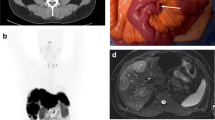Summary and Conclusions
Knowledge of carcinoid tumors of the gastrointestinal tract has incerased rapidly for two decades but the greatest advance has been made during the past four years. All characteristics of carcinoid tumors have been so variable that their inconsistency has attracted much attention. Recent studies of the chemistry of carcinoid tumors have resulted in the discovery of serotonin, a secretion produced by the tumor, which is believed to have a significant relationship to symptoms and spread of the disease. The proctologist’s responsibility in connection with the diagnosis of carcinoid tumors of the rectum is obvious. Once a diagnosis of carcinoid disease is made, a resection of the lesion is always indicated. It is my belief that resection of the lesion is indicated in cases where carcinoid disease is only suspected. Probably the rate of incidence of this disease is not increasing and the apparent increase is owing to the frequency of its recognition. Furthermore, there is every reason to believe that this apparent increase will become more noticeable as our knowledge of the peculiarities of carcinoids continues to improve.
Similar content being viewed by others
References
Ariel, I. M.: Argentaffin (carcinoid) tumors of the small intestine: Report of 11 cases and review of literature. Arch. Path.27: 25, 1939.
Beger, A.: Ein Fall von Krebs des Wurmfortsatzes. Berl. klin. Wchnschr.19: 616, 1882.
Brunschwig, A.: Argentaffin tumor (carcinoid) of the rectal colon. J.A.M.A.100: 1171, 1933.
Erspamer, V. and B. Asero: Identification of enteramine, the specific hormone of the enterochromaffin cell system, as 5-hydroxytryptamine. Nature.169: 800, 1952.
Gosset, A. and P. Masson: Tumeurs endocrines de l’appendice. Presse méd.1: 237, 1914.
Grimes, O. F. and H. G. Bell: Carcinoid tumors of the intestine. Surg., Gynec. & Obst.88: 317, 1949.
Hopping, R. A., M. B. Dockerty and J. C. Masson: Carcinoid tumor of the appendix; report of a case in which extensive intra-abdominal metastases occurred, including involvement of right ovary. Arch. Surg.45: 613, 1942.
Horsley, G. W. and B. N. Golden: Carcinoid tumors of the duodenum. Internat. Abstr. Surg.105: 417, 1957.
Kultschitzky, N.: Zur Frage über den Bau des Darmkanals. Arch. f. mikr. Anat.49: 7, 1897.
Langhans, T.: Quoted by Ewing, J.: Neoplastic Diseases; a Treatise on Tumors. Ed. 4, Philadelphia, W. B. Saunders Company, 1940.
Lattes, R. and C. Grossi: Carcinoid tumors of the stomach. Cancer.9: 698, 1956.
Lembeck, F.: 5-Hydroxytryptamine in a carcinoid tumour. Nature.172: 910, 1953.
Lubarsch, O.: Ueber den primären Krebs des Ileum nebst Bemerkungen über das gleichzeitige Vorkommen von Krebs und Tuberculose. Virchows Arch. f. path. Anat.111: 280, 1888.
Masson, P.: Carcinoids (argentaffin-cell tumors) and nerve hyperplasia of the appendicular mucosa. Am. J. Path.4: 181, 1928.
Mattingly, T. W. and A. Sjoerdsma: The cardiovascular manifestations of functioning carcinoid tumors. Modern Concepts of Cardiovascular Disease.25: 337, 1956.
Oberndorfer, S.: Ueber die “kleinen Dünndarmcarcinome.” Verhandl. deutsch. path. Gesellsch.11: 113, 1907.
Pearson, C. M. and P. J. Fitzgerald: Carcinoid tumors; a re-emphasis of their malignant nature: Review of 140 cases. Cancer.2: 1005, 1949.
Raiford, T. S.: Carcinoid tumors of the gastrointestinal tract (so-called argentaffine tumors). Am. J. Cancer18: 803, 1933.
Rapport, M. M.: Serum vasoconstrictor (serotonin): The presence of creatinine in the complex. A proposed structure of the vasoconstrictor principle. J. Biol. Chem.180: 961, 1949.
Stout, A. P.: Carcinoid tumors of the rectum derived from Erspamer’s pre-enterochrome cells. Am. J. Path.18: 993, 1942.
Thorson, A., G. Biorck, G. Bjorkman and J. Waldenstrom: Malignant carcinoid of the small intestine with metastases to the liver, valvular disease of the right side of the heart (pulmonary stenosis and tricuspid regurgitation without septal defects), peripheral vasomotor symptoms, bronchoconstriction and an unusual type of cyanosis: A clinical and pathologic syndrome. Am. Heart J.47: 795, 1954.
Undenfriend, S. and E. Titus: The 5-hydroxyindole pathway of tryptophan metabolism: Amino acid metabolism. Baltimore, The Johns Hopkins Press, 1955, p. 945.
Weiss, G. N. and A. J. Hertzog: Carcinoid tumors of the appendix: A review of twenty-six cases. Surgery.30: 657, 1951.
Author information
Authors and Affiliations
Additional information
Read at the meeting of the American Proctologic Society, Los Angeles, California, June 29 to July 3, 1958.
About this article
Cite this article
Copland, S.M. Carcinoid disease. Dis Colon Rectum 1, 471–476 (1958). https://doi.org/10.1007/BF02633417
Issue Date:
DOI: https://doi.org/10.1007/BF02633417




